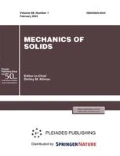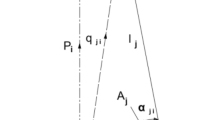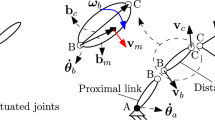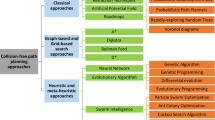Abstract—
Performance measures have been utilized for numerous applications in robotics research. In this paper, the manipulability and dexterity indices have been focused. These indices have been used successfully when parallel robots have either completely revolute or prismatic joints. But, in a manipulator with both revolute and prismatic joints, these may not be used because of the dimensional inconsistency of the components in the Jacobian matrix. Moreover, in the kinematic or dynamic case, for manipulability and dexterity analysis, the Euclidean norm for the velocity inputs is considered while the velocity inputs for active joints are generally independent; therefore, the manipulability and dexterity indices are explained based on the infinity-norm. Thus, the final solution is represented by the new concept of mixed manipulability polytope. Next, an example of the 3-RPC parallel robot is analyzed based on the notion of this index. As an application, the index is applied for trajectory planning in multi-objective optimal control. For this, one of the direct methods of optimal control, dynamic programming (DP), is selected. But for the DP, the genetic algorithm (GA) is used for searching the optimum path. This analysis is applied for a novel PU-3RPR redundant parallel manipulator. First, the parallel mechanism is introduced, and the kinematics and Jacobian analysis is discussed. Then the objective function that minimizes the pseudo kinetic energy and maximizes the index, is adopted for an optimization problem. Finally, the trajectory of the PU-3RPR redundant parallel mechanism is planned by the proposed GA-DP method.









Similar content being viewed by others
REFERENCES
M. Bamdad and M. M. Bahri, “Kinematics and manipulability analysis of a highly articulated soft robotic manipulator,” Robotica 37, 868-882 (2019).
E. Mirshekari, A. Ghanbarzadeh, and K. H. Shirazia, “Structure comparison and optimal design of 6-RUS parallel manipulator based on kinematic and dynamic performances,” Lat. Am. J. Solids Struct. 13, 2414–2438 (2016).
S. Kucuk and Z. Bingul, “Comparative study of performance indices for fundamental robot manipulators,” Rob. Auton. Syst. 54, 567–573 (2006).
S. Kucuk, “A dexterity comparison for 3-DOF planar parallel manipulators with two kinematic chains using genetic algorithms,” Mechatronics 19, 868–877 (2009).
C. Zhang, Y. Chen, H. Xu, et. al., “Kinematic modeling and dexterity evaluation of a PS-RRS-2RUS parallel manipulator used for controllable pitch propeller,” Mech. Based Des. Struct. Mach. 46, 533–551 (2018).
S. Shayya, S. Krut, O. Company, et al. “On the performance evaluation and analysis of general robots with mixed dofs,” in Intelligent Robots and Systems (IROS 2014), Chicago, IL, 2014, pp. 490–497.
A. Bowling and O. Khatib, “Dynamic loading criteria in actuator selection for desired dynamic performance,” Adv. Rob. 17, 641–656 (2003).
S.-G. Kim and J. Ryu, “Force transmission analyses with dimensionally homogeneous jacobian matrices for parallel manipulators,” J. Mech. Sci. Technol. 18, 780–788 (2004).
G. Boschetti, R. Rosa, and A. Trevisani, “Parallel robot translational performance evaluation through direction-selective index (DSI),” J. Rob. 2011 (2011).
I. Mansouri and M. Ouali, “The power manipulability–A new homogeneous performance index of robot manipulators,” Rob. Comput. Integr. Manuf. 27, 434–449 (2011).
A. P. Bowling, “Dynamic performance, mobility, and agility of multilegged robots,” J. Dyn. Syst., Meas., Control. 128, 765–777 (2006).
S. G. Kim and J. Ryu, “New dimensionally homogeneous Jacobian matrix formulation by three end-effector points for optimal design of parallel manipulators,” IEEE Trans. Rob. Autom. 19, 731–736 (2003).
O. Altuzarra, O. Salgado, V. Petuya, and A. Hernández, “Point-based Jacobian formulation for computational kinematics of manipulators,” Mech. Mach. Theory. 41, 1407–1423 (2006).
G. Pond and J. A. Carretero, “Dexterity measures and their use in quantitative dexterity comparisons,” Meccanica 46, 51–64 (2011).
J. P. Merlet, “Jacobian, manipulability, condition number, and accuracy of parallel robots,” Journal of Mechanical Design. 128, 199–206 (2006).
K. C. Olds, “Global Indices for kinematic and force transmission performance in parallel robots,” IEEE Transactions on Robotics. 31, 494–500 (2015).
Q. Meng, F. Xie, X.-J. Liu, and Y. Takeda, “Screw Theory-Based Motion/Force Transmissibility Analysis of High-Speed Parallel Robots With Articulated Platforms,” Journal of Mechanisms and Robotics. 12 (2020).
T. Yoshikawa, Foundations of Robotics: Analysis and Control (MIT press, 1990).
Y. Nakamura and H. Hanafusa, “Optimal redundancy control of robot manipulators,” Int. J. Rob. Res. 6, 32–42 (1987).
T. Chettibi, H. Lehtihet, M. Haddad, and S. Hanchi, “Minimum cost trajectory planning for industrial robots,” Eur. J. Mech. A/Solids. 23, 703–715 (2004).
O. Wigström and B. Lennartson, “Energy optimization of trajectories for high level scheduling,” in 2011 IEEE International Conference on Automation Science and Engineering, Trieste, 2011, pp. 654–659.
O. Wigstrom, B. Lennartson, A. Vergnano, and C. Breitholtz, “High-level scheduling of energy optimal trajectories,” IEEE Trans. Autom. Sci. Eng. 10, 57–64 (2013).
C. M. Gosselin, “The optimum design of robotic manipulators using dexterity indices,” Rob. Auton. Syst. 9, 213–226 (1992).
X. Kong and C. M. Gosselin, “Type synthesis of 3-DOF translational parallel manipulators based on screw theory,” J. Mech. Des. 126, 83–92 (2004).
X. Kong and C. M. Gosselin, Type Synthesis of Parallel Mechanisms Vol. 33 (Springer, 2007).
I. Prause, M. Lorenz, and B. Corves, “Kinetostatic analysis of the translational RPC-manipulator with different actuator and frame configurations,” in 2015 IEEE International Conference on Robotics and Automation (ICRA) (Seattle, 2015), pp. 1605–1612.
I. Prause and B. Corves, “Dynamic modeling of the RPC-manipulator with prismatic or revolute joint actuation for different frame configurations,” in 2015 IEEE/RSJ International Conference on Intelligent Robots and Systems (IROS) (Hamburg, 2015), pp. 4105–4112.
D. S. Naidu, Optimal Control Systems (CRC Press, 2002).
W. Alt, U. Felgenhauer, and M. Seydenschwanz, “Euler discretization for a class of nonlinear optimal control problems with control appearing linearly,” Comput. Optim. Appl. 69, 825–856 (2018).
V. Azimirad and H. Shorakaei, “Dual hierarchical genetic-optimal control: A new global optimal path planning method for robots,” J. Manuf. Syst. 33, 139–148 (2014).
H. Khakpour, L. Birglen, and S.-A. Tahan, “Analysis and optimization of a new differentially driven cable parallel robot,” J. Mech. Rob. 7, 034503 (2015).
Y. Nakamura, Advanced Robotics: Redundancy and Optimization (Addison-Wesley, Inc., 1990).
Author information
Authors and Affiliations
Corresponding authors
About this article
Cite this article
Badrikouhi, M., Bamdad, M. Novel Manipulability for Parallel Mechanisms with Prismatic-Revolute Actuators, GA-DP Trajectory Planning Application. Mech. Solids 56, 278–291 (2021). https://doi.org/10.3103/S0025654421020023
Received:
Revised:
Accepted:
Published:
Issue Date:
DOI: https://doi.org/10.3103/S0025654421020023




